Report on Visitor Attraction Management and Strategies
VerifiedAdded on 2020/01/16
|15
|5216
|329
Report
AI Summary
This report provides a comprehensive analysis of visitor attraction management. It begins with an introduction to the topic, emphasizing the importance of managing visitor attractions for economic growth and visitor satisfaction. The report then delves into the overlap between different types of attractions, highlighting their significance. It explores the needs and motivations of various visitor types, discussing market segmentation strategies. The impact of tourism on visitor attractions, both positive and negative, is examined, including economic and environmental considerations. Furthermore, the report analyzes the influence of tourist motivation theories on visitor attraction management and explores the processes and issues involved in developing visitor attractions. Finally, it presents various visitor management strategies and evaluates their effectiveness in relation to sustainability, concluding with key insights and recommendations for effective visitor attraction management.
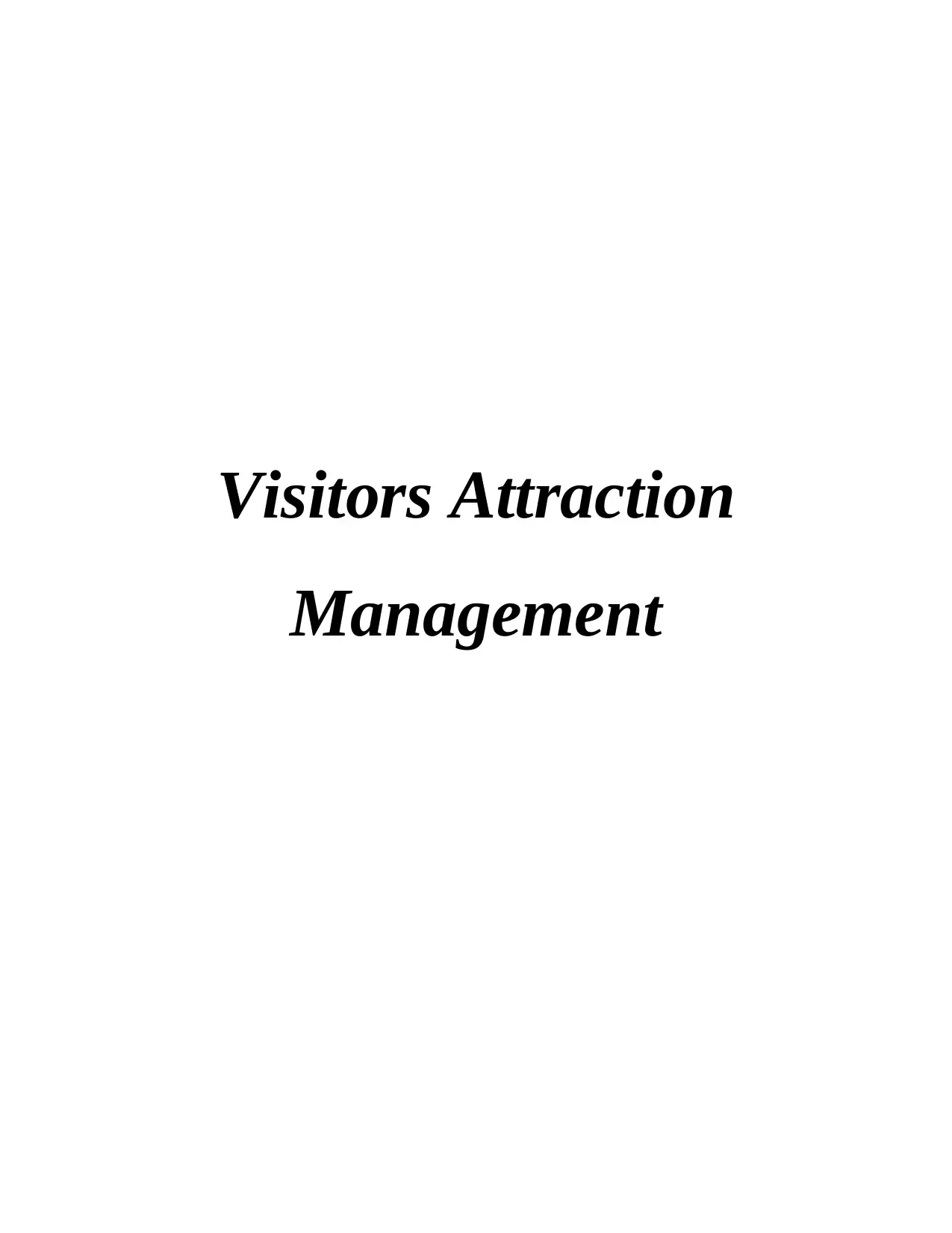
Visitors Attraction
Management
Management
Paraphrase This Document
Need a fresh take? Get an instant paraphrase of this document with our AI Paraphraser
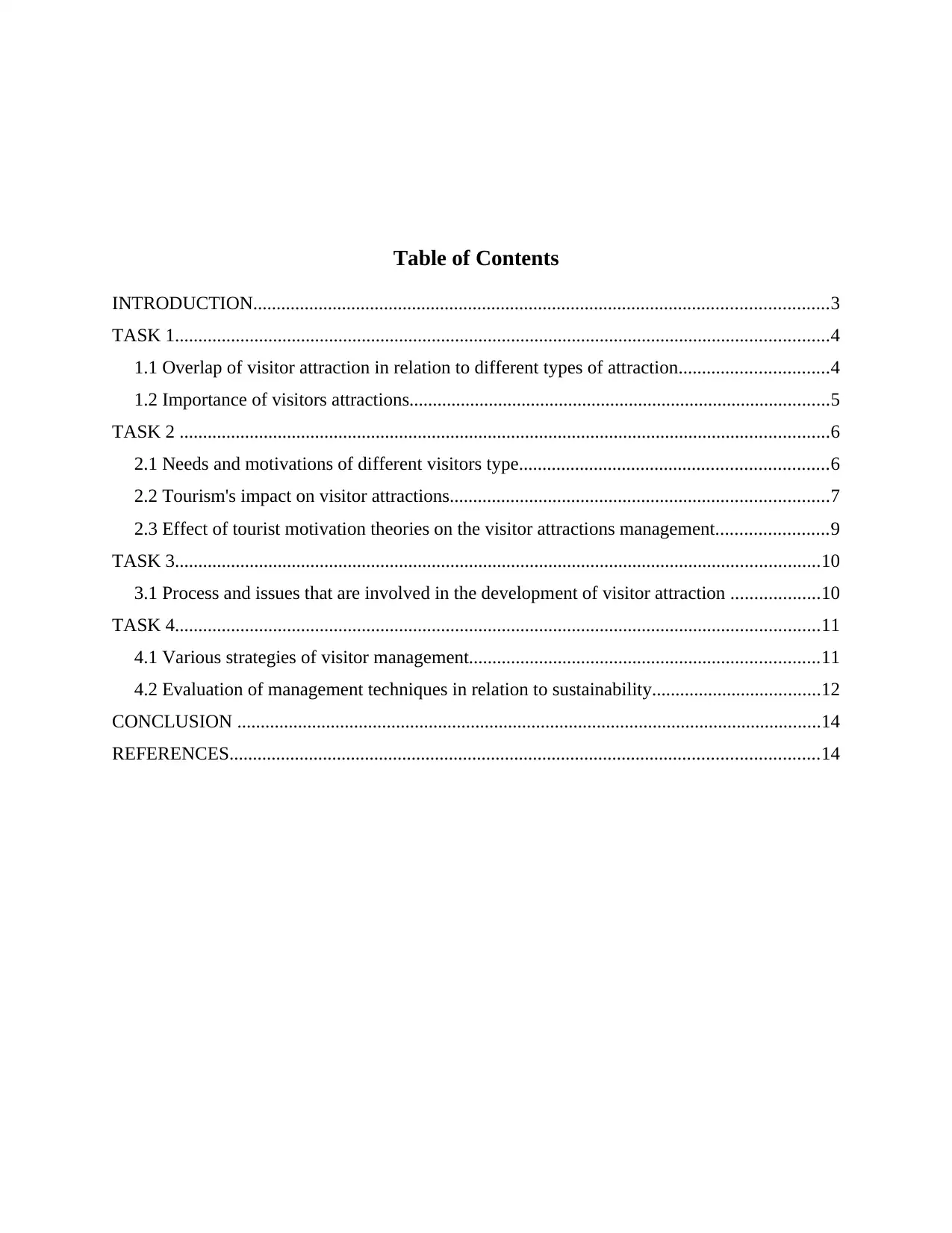
Table of Contents
INTRODUCTION...........................................................................................................................3
TASK 1............................................................................................................................................4
1.1 Overlap of visitor attraction in relation to different types of attraction................................4
1.2 Importance of visitors attractions..........................................................................................5
TASK 2 ...........................................................................................................................................6
2.1 Needs and motivations of different visitors type..................................................................6
2.2 Tourism's impact on visitor attractions.................................................................................7
2.3 Effect of tourist motivation theories on the visitor attractions management........................9
TASK 3..........................................................................................................................................10
3.1 Process and issues that are involved in the development of visitor attraction ...................10
TASK 4..........................................................................................................................................11
4.1 Various strategies of visitor management...........................................................................11
4.2 Evaluation of management techniques in relation to sustainability....................................12
CONCLUSION .............................................................................................................................14
REFERENCES..............................................................................................................................14
INTRODUCTION...........................................................................................................................3
TASK 1............................................................................................................................................4
1.1 Overlap of visitor attraction in relation to different types of attraction................................4
1.2 Importance of visitors attractions..........................................................................................5
TASK 2 ...........................................................................................................................................6
2.1 Needs and motivations of different visitors type..................................................................6
2.2 Tourism's impact on visitor attractions.................................................................................7
2.3 Effect of tourist motivation theories on the visitor attractions management........................9
TASK 3..........................................................................................................................................10
3.1 Process and issues that are involved in the development of visitor attraction ...................10
TASK 4..........................................................................................................................................11
4.1 Various strategies of visitor management...........................................................................11
4.2 Evaluation of management techniques in relation to sustainability....................................12
CONCLUSION .............................................................................................................................14
REFERENCES..............................................................................................................................14
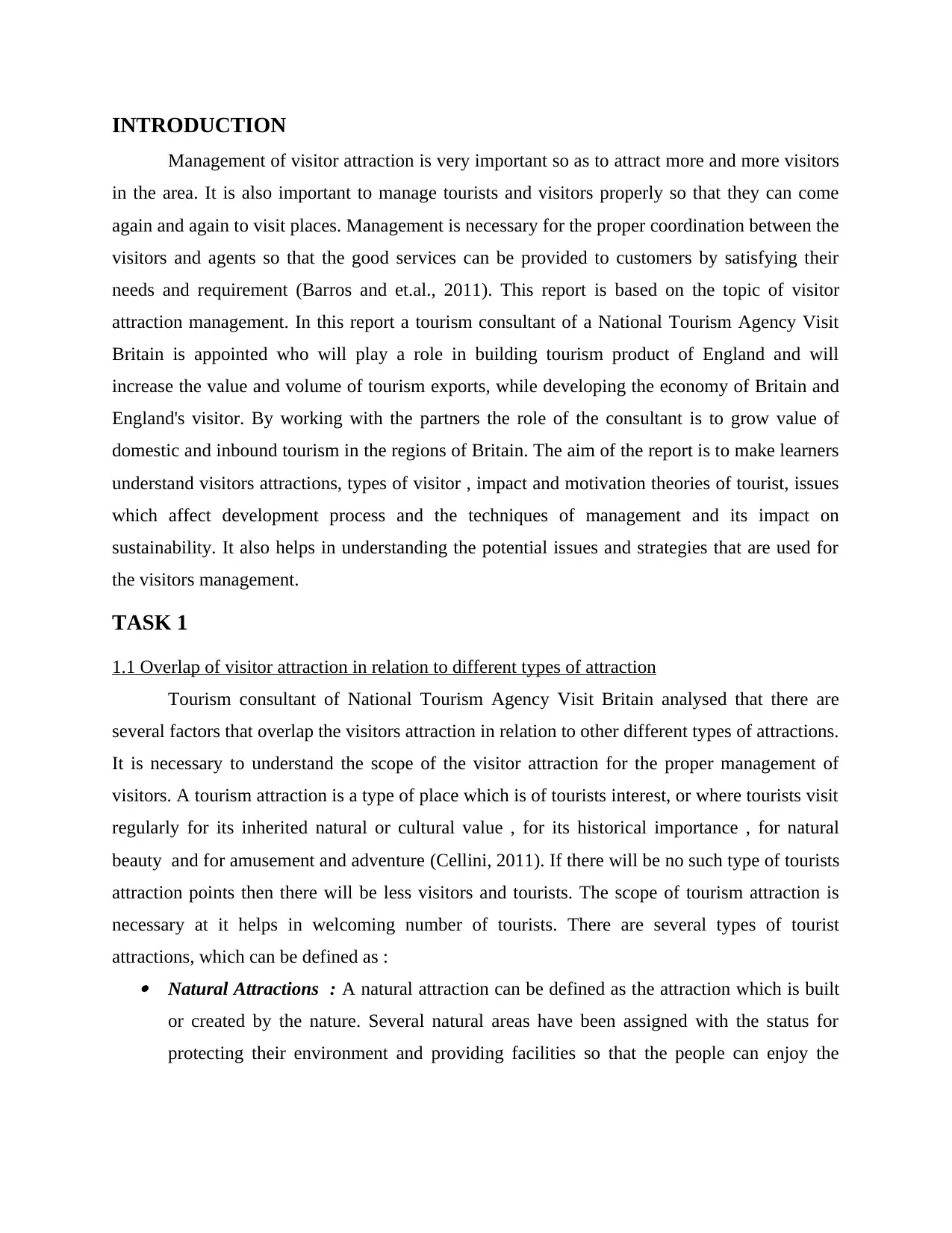
INTRODUCTION
Management of visitor attraction is very important so as to attract more and more visitors
in the area. It is also important to manage tourists and visitors properly so that they can come
again and again to visit places. Management is necessary for the proper coordination between the
visitors and agents so that the good services can be provided to customers by satisfying their
needs and requirement (Barros and et.al., 2011). This report is based on the topic of visitor
attraction management. In this report a tourism consultant of a National Tourism Agency Visit
Britain is appointed who will play a role in building tourism product of England and will
increase the value and volume of tourism exports, while developing the economy of Britain and
England's visitor. By working with the partners the role of the consultant is to grow value of
domestic and inbound tourism in the regions of Britain. The aim of the report is to make learners
understand visitors attractions, types of visitor , impact and motivation theories of tourist, issues
which affect development process and the techniques of management and its impact on
sustainability. It also helps in understanding the potential issues and strategies that are used for
the visitors management.
TASK 1
1.1 Overlap of visitor attraction in relation to different types of attraction
Tourism consultant of National Tourism Agency Visit Britain analysed that there are
several factors that overlap the visitors attraction in relation to other different types of attractions.
It is necessary to understand the scope of the visitor attraction for the proper management of
visitors. A tourism attraction is a type of place which is of tourists interest, or where tourists visit
regularly for its inherited natural or cultural value , for its historical importance , for natural
beauty and for amusement and adventure (Cellini, 2011). If there will be no such type of tourists
attraction points then there will be less visitors and tourists. The scope of tourism attraction is
necessary at it helps in welcoming number of tourists. There are several types of tourist
attractions, which can be defined as : Natural Attractions : A natural attraction can be defined as the attraction which is built
or created by the nature. Several natural areas have been assigned with the status for
protecting their environment and providing facilities so that the people can enjoy the
Management of visitor attraction is very important so as to attract more and more visitors
in the area. It is also important to manage tourists and visitors properly so that they can come
again and again to visit places. Management is necessary for the proper coordination between the
visitors and agents so that the good services can be provided to customers by satisfying their
needs and requirement (Barros and et.al., 2011). This report is based on the topic of visitor
attraction management. In this report a tourism consultant of a National Tourism Agency Visit
Britain is appointed who will play a role in building tourism product of England and will
increase the value and volume of tourism exports, while developing the economy of Britain and
England's visitor. By working with the partners the role of the consultant is to grow value of
domestic and inbound tourism in the regions of Britain. The aim of the report is to make learners
understand visitors attractions, types of visitor , impact and motivation theories of tourist, issues
which affect development process and the techniques of management and its impact on
sustainability. It also helps in understanding the potential issues and strategies that are used for
the visitors management.
TASK 1
1.1 Overlap of visitor attraction in relation to different types of attraction
Tourism consultant of National Tourism Agency Visit Britain analysed that there are
several factors that overlap the visitors attraction in relation to other different types of attractions.
It is necessary to understand the scope of the visitor attraction for the proper management of
visitors. A tourism attraction is a type of place which is of tourists interest, or where tourists visit
regularly for its inherited natural or cultural value , for its historical importance , for natural
beauty and for amusement and adventure (Cellini, 2011). If there will be no such type of tourists
attraction points then there will be less visitors and tourists. The scope of tourism attraction is
necessary at it helps in welcoming number of tourists. There are several types of tourist
attractions, which can be defined as : Natural Attractions : A natural attraction can be defined as the attraction which is built
or created by the nature. Several natural areas have been assigned with the status for
protecting their environment and providing facilities so that the people can enjoy the
⊘ This is a preview!⊘
Do you want full access?
Subscribe today to unlock all pages.

Trusted by 1+ million students worldwide
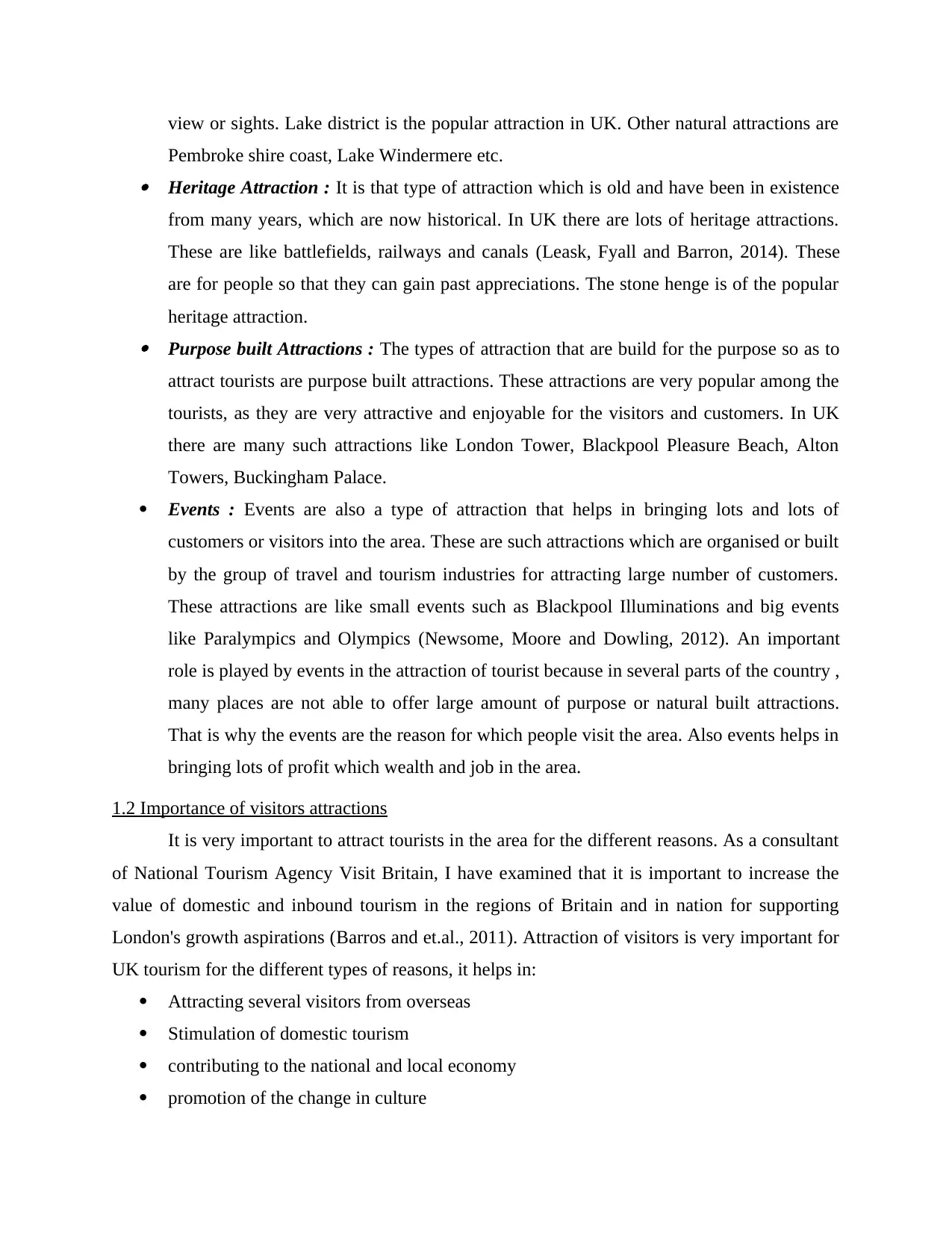
view or sights. Lake district is the popular attraction in UK. Other natural attractions are
Pembroke shire coast, Lake Windermere etc. Heritage Attraction : It is that type of attraction which is old and have been in existence
from many years, which are now historical. In UK there are lots of heritage attractions.
These are like battlefields, railways and canals (Leask, Fyall and Barron, 2014). These
are for people so that they can gain past appreciations. The stone henge is of the popular
heritage attraction. Purpose built Attractions : The types of attraction that are build for the purpose so as to
attract tourists are purpose built attractions. These attractions are very popular among the
tourists, as they are very attractive and enjoyable for the visitors and customers. In UK
there are many such attractions like London Tower, Blackpool Pleasure Beach, Alton
Towers, Buckingham Palace.
Events : Events are also a type of attraction that helps in bringing lots and lots of
customers or visitors into the area. These are such attractions which are organised or built
by the group of travel and tourism industries for attracting large number of customers.
These attractions are like small events such as Blackpool Illuminations and big events
like Paralympics and Olympics (Newsome, Moore and Dowling, 2012). An important
role is played by events in the attraction of tourist because in several parts of the country ,
many places are not able to offer large amount of purpose or natural built attractions.
That is why the events are the reason for which people visit the area. Also events helps in
bringing lots of profit which wealth and job in the area.
1.2 Importance of visitors attractions
It is very important to attract tourists in the area for the different reasons. As a consultant
of National Tourism Agency Visit Britain, I have examined that it is important to increase the
value of domestic and inbound tourism in the regions of Britain and in nation for supporting
London's growth aspirations (Barros and et.al., 2011). Attraction of visitors is very important for
UK tourism for the different types of reasons, it helps in:
Attracting several visitors from overseas
Stimulation of domestic tourism
contributing to the national and local economy
promotion of the change in culture
Pembroke shire coast, Lake Windermere etc. Heritage Attraction : It is that type of attraction which is old and have been in existence
from many years, which are now historical. In UK there are lots of heritage attractions.
These are like battlefields, railways and canals (Leask, Fyall and Barron, 2014). These
are for people so that they can gain past appreciations. The stone henge is of the popular
heritage attraction. Purpose built Attractions : The types of attraction that are build for the purpose so as to
attract tourists are purpose built attractions. These attractions are very popular among the
tourists, as they are very attractive and enjoyable for the visitors and customers. In UK
there are many such attractions like London Tower, Blackpool Pleasure Beach, Alton
Towers, Buckingham Palace.
Events : Events are also a type of attraction that helps in bringing lots and lots of
customers or visitors into the area. These are such attractions which are organised or built
by the group of travel and tourism industries for attracting large number of customers.
These attractions are like small events such as Blackpool Illuminations and big events
like Paralympics and Olympics (Newsome, Moore and Dowling, 2012). An important
role is played by events in the attraction of tourist because in several parts of the country ,
many places are not able to offer large amount of purpose or natural built attractions.
That is why the events are the reason for which people visit the area. Also events helps in
bringing lots of profit which wealth and job in the area.
1.2 Importance of visitors attractions
It is very important to attract tourists in the area for the different reasons. As a consultant
of National Tourism Agency Visit Britain, I have examined that it is important to increase the
value of domestic and inbound tourism in the regions of Britain and in nation for supporting
London's growth aspirations (Barros and et.al., 2011). Attraction of visitors is very important for
UK tourism for the different types of reasons, it helps in:
Attracting several visitors from overseas
Stimulation of domestic tourism
contributing to the national and local economy
promotion of the change in culture
Paraphrase This Document
Need a fresh take? Get an instant paraphrase of this document with our AI Paraphraser
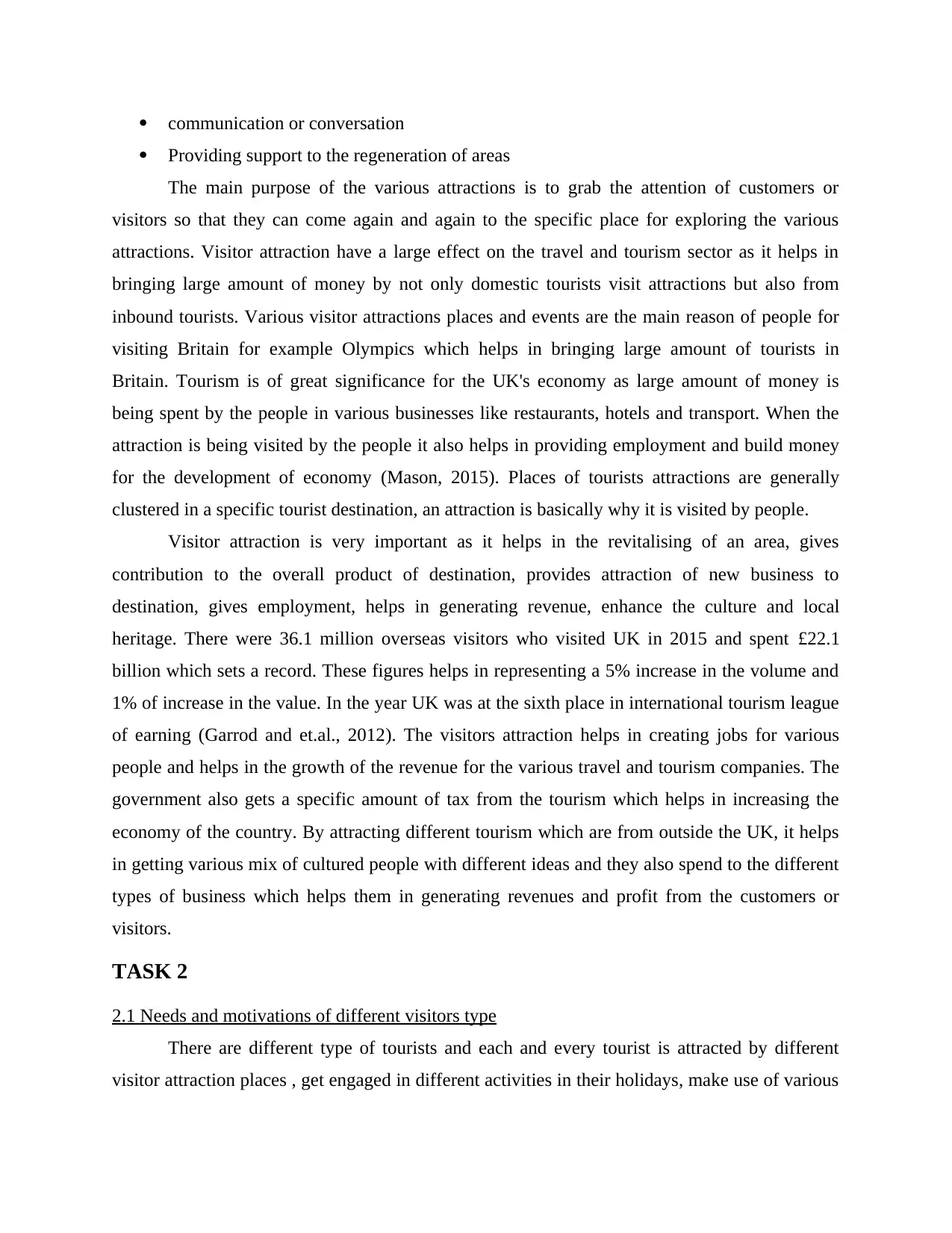
communication or conversation
Providing support to the regeneration of areas
The main purpose of the various attractions is to grab the attention of customers or
visitors so that they can come again and again to the specific place for exploring the various
attractions. Visitor attraction have a large effect on the travel and tourism sector as it helps in
bringing large amount of money by not only domestic tourists visit attractions but also from
inbound tourists. Various visitor attractions places and events are the main reason of people for
visiting Britain for example Olympics which helps in bringing large amount of tourists in
Britain. Tourism is of great significance for the UK's economy as large amount of money is
being spent by the people in various businesses like restaurants, hotels and transport. When the
attraction is being visited by the people it also helps in providing employment and build money
for the development of economy (Mason, 2015). Places of tourists attractions are generally
clustered in a specific tourist destination, an attraction is basically why it is visited by people.
Visitor attraction is very important as it helps in the revitalising of an area, gives
contribution to the overall product of destination, provides attraction of new business to
destination, gives employment, helps in generating revenue, enhance the culture and local
heritage. There were 36.1 million overseas visitors who visited UK in 2015 and spent £22.1
billion which sets a record. These figures helps in representing a 5% increase in the volume and
1% of increase in the value. In the year UK was at the sixth place in international tourism league
of earning (Garrod and et.al., 2012). The visitors attraction helps in creating jobs for various
people and helps in the growth of the revenue for the various travel and tourism companies. The
government also gets a specific amount of tax from the tourism which helps in increasing the
economy of the country. By attracting different tourism which are from outside the UK, it helps
in getting various mix of cultured people with different ideas and they also spend to the different
types of business which helps them in generating revenues and profit from the customers or
visitors.
TASK 2
2.1 Needs and motivations of different visitors type
There are different type of tourists and each and every tourist is attracted by different
visitor attraction places , get engaged in different activities in their holidays, make use of various
Providing support to the regeneration of areas
The main purpose of the various attractions is to grab the attention of customers or
visitors so that they can come again and again to the specific place for exploring the various
attractions. Visitor attraction have a large effect on the travel and tourism sector as it helps in
bringing large amount of money by not only domestic tourists visit attractions but also from
inbound tourists. Various visitor attractions places and events are the main reason of people for
visiting Britain for example Olympics which helps in bringing large amount of tourists in
Britain. Tourism is of great significance for the UK's economy as large amount of money is
being spent by the people in various businesses like restaurants, hotels and transport. When the
attraction is being visited by the people it also helps in providing employment and build money
for the development of economy (Mason, 2015). Places of tourists attractions are generally
clustered in a specific tourist destination, an attraction is basically why it is visited by people.
Visitor attraction is very important as it helps in the revitalising of an area, gives
contribution to the overall product of destination, provides attraction of new business to
destination, gives employment, helps in generating revenue, enhance the culture and local
heritage. There were 36.1 million overseas visitors who visited UK in 2015 and spent £22.1
billion which sets a record. These figures helps in representing a 5% increase in the volume and
1% of increase in the value. In the year UK was at the sixth place in international tourism league
of earning (Garrod and et.al., 2012). The visitors attraction helps in creating jobs for various
people and helps in the growth of the revenue for the various travel and tourism companies. The
government also gets a specific amount of tax from the tourism which helps in increasing the
economy of the country. By attracting different tourism which are from outside the UK, it helps
in getting various mix of cultured people with different ideas and they also spend to the different
types of business which helps them in generating revenues and profit from the customers or
visitors.
TASK 2
2.1 Needs and motivations of different visitors type
There are different type of tourists and each and every tourist is attracted by different
visitor attraction places , get engaged in different activities in their holidays, make use of various
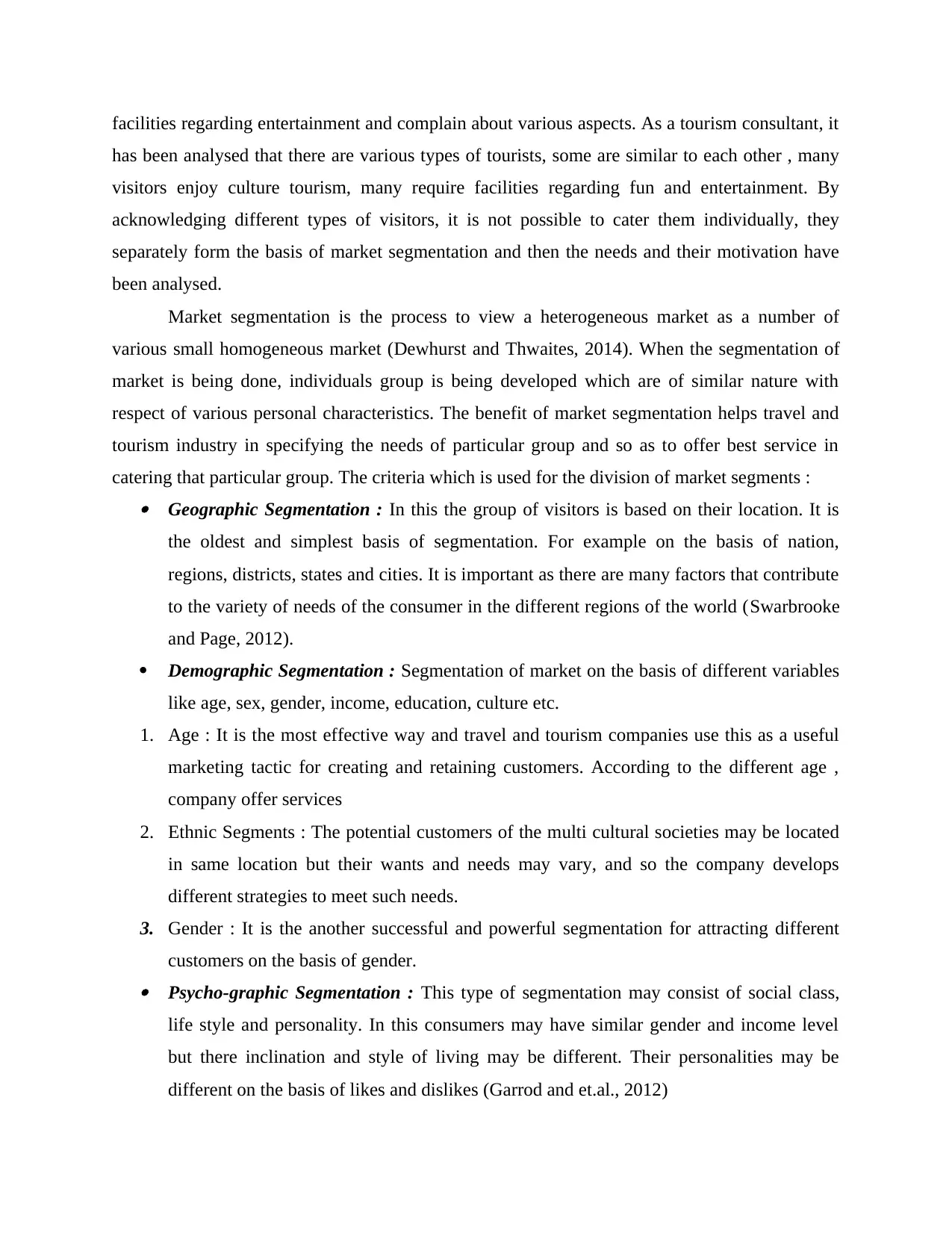
facilities regarding entertainment and complain about various aspects. As a tourism consultant, it
has been analysed that there are various types of tourists, some are similar to each other , many
visitors enjoy culture tourism, many require facilities regarding fun and entertainment. By
acknowledging different types of visitors, it is not possible to cater them individually, they
separately form the basis of market segmentation and then the needs and their motivation have
been analysed.
Market segmentation is the process to view a heterogeneous market as a number of
various small homogeneous market (Dewhurst and Thwaites, 2014). When the segmentation of
market is being done, individuals group is being developed which are of similar nature with
respect of various personal characteristics. The benefit of market segmentation helps travel and
tourism industry in specifying the needs of particular group and so as to offer best service in
catering that particular group. The criteria which is used for the division of market segments : Geographic Segmentation : In this the group of visitors is based on their location. It is
the oldest and simplest basis of segmentation. For example on the basis of nation,
regions, districts, states and cities. It is important as there are many factors that contribute
to the variety of needs of the consumer in the different regions of the world (Swarbrooke
and Page, 2012).
Demographic Segmentation : Segmentation of market on the basis of different variables
like age, sex, gender, income, education, culture etc.
1. Age : It is the most effective way and travel and tourism companies use this as a useful
marketing tactic for creating and retaining customers. According to the different age ,
company offer services
2. Ethnic Segments : The potential customers of the multi cultural societies may be located
in same location but their wants and needs may vary, and so the company develops
different strategies to meet such needs.
3. Gender : It is the another successful and powerful segmentation for attracting different
customers on the basis of gender. Psycho-graphic Segmentation : This type of segmentation may consist of social class,
life style and personality. In this consumers may have similar gender and income level
but there inclination and style of living may be different. Their personalities may be
different on the basis of likes and dislikes (Garrod and et.al., 2012)
has been analysed that there are various types of tourists, some are similar to each other , many
visitors enjoy culture tourism, many require facilities regarding fun and entertainment. By
acknowledging different types of visitors, it is not possible to cater them individually, they
separately form the basis of market segmentation and then the needs and their motivation have
been analysed.
Market segmentation is the process to view a heterogeneous market as a number of
various small homogeneous market (Dewhurst and Thwaites, 2014). When the segmentation of
market is being done, individuals group is being developed which are of similar nature with
respect of various personal characteristics. The benefit of market segmentation helps travel and
tourism industry in specifying the needs of particular group and so as to offer best service in
catering that particular group. The criteria which is used for the division of market segments : Geographic Segmentation : In this the group of visitors is based on their location. It is
the oldest and simplest basis of segmentation. For example on the basis of nation,
regions, districts, states and cities. It is important as there are many factors that contribute
to the variety of needs of the consumer in the different regions of the world (Swarbrooke
and Page, 2012).
Demographic Segmentation : Segmentation of market on the basis of different variables
like age, sex, gender, income, education, culture etc.
1. Age : It is the most effective way and travel and tourism companies use this as a useful
marketing tactic for creating and retaining customers. According to the different age ,
company offer services
2. Ethnic Segments : The potential customers of the multi cultural societies may be located
in same location but their wants and needs may vary, and so the company develops
different strategies to meet such needs.
3. Gender : It is the another successful and powerful segmentation for attracting different
customers on the basis of gender. Psycho-graphic Segmentation : This type of segmentation may consist of social class,
life style and personality. In this consumers may have similar gender and income level
but there inclination and style of living may be different. Their personalities may be
different on the basis of likes and dislikes (Garrod and et.al., 2012)
⊘ This is a preview!⊘
Do you want full access?
Subscribe today to unlock all pages.

Trusted by 1+ million students worldwide
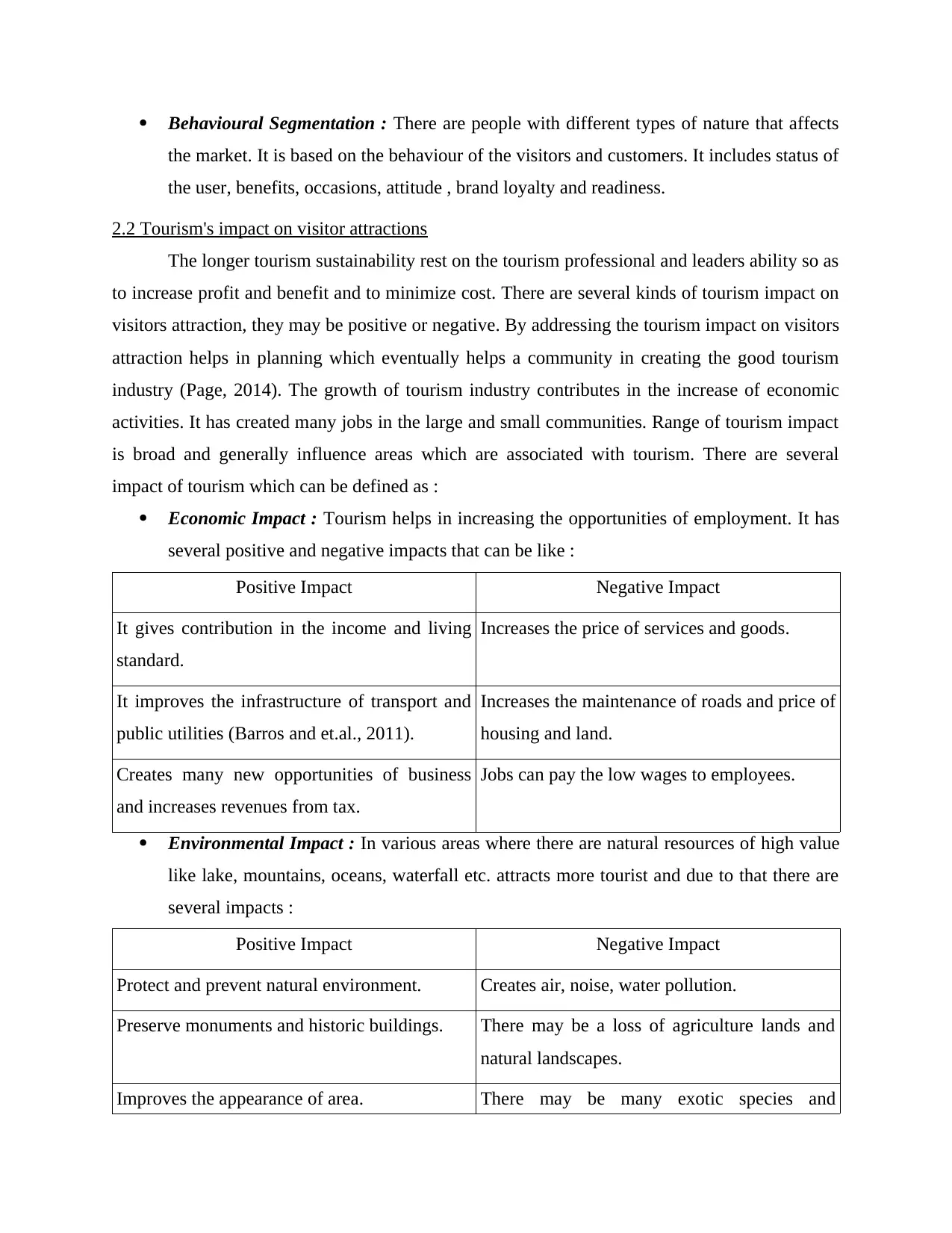
Behavioural Segmentation : There are people with different types of nature that affects
the market. It is based on the behaviour of the visitors and customers. It includes status of
the user, benefits, occasions, attitude , brand loyalty and readiness.
2.2 Tourism's impact on visitor attractions
The longer tourism sustainability rest on the tourism professional and leaders ability so as
to increase profit and benefit and to minimize cost. There are several kinds of tourism impact on
visitors attraction, they may be positive or negative. By addressing the tourism impact on visitors
attraction helps in planning which eventually helps a community in creating the good tourism
industry (Page, 2014). The growth of tourism industry contributes in the increase of economic
activities. It has created many jobs in the large and small communities. Range of tourism impact
is broad and generally influence areas which are associated with tourism. There are several
impact of tourism which can be defined as :
Economic Impact : Tourism helps in increasing the opportunities of employment. It has
several positive and negative impacts that can be like :
Positive Impact Negative Impact
It gives contribution in the income and living
standard.
Increases the price of services and goods.
It improves the infrastructure of transport and
public utilities (Barros and et.al., 2011).
Increases the maintenance of roads and price of
housing and land.
Creates many new opportunities of business
and increases revenues from tax.
Jobs can pay the low wages to employees.
Environmental Impact : In various areas where there are natural resources of high value
like lake, mountains, oceans, waterfall etc. attracts more tourist and due to that there are
several impacts :
Positive Impact Negative Impact
Protect and prevent natural environment. Creates air, noise, water pollution.
Preserve monuments and historic buildings. There may be a loss of agriculture lands and
natural landscapes.
Improves the appearance of area. There may be many exotic species and
the market. It is based on the behaviour of the visitors and customers. It includes status of
the user, benefits, occasions, attitude , brand loyalty and readiness.
2.2 Tourism's impact on visitor attractions
The longer tourism sustainability rest on the tourism professional and leaders ability so as
to increase profit and benefit and to minimize cost. There are several kinds of tourism impact on
visitors attraction, they may be positive or negative. By addressing the tourism impact on visitors
attraction helps in planning which eventually helps a community in creating the good tourism
industry (Page, 2014). The growth of tourism industry contributes in the increase of economic
activities. It has created many jobs in the large and small communities. Range of tourism impact
is broad and generally influence areas which are associated with tourism. There are several
impact of tourism which can be defined as :
Economic Impact : Tourism helps in increasing the opportunities of employment. It has
several positive and negative impacts that can be like :
Positive Impact Negative Impact
It gives contribution in the income and living
standard.
Increases the price of services and goods.
It improves the infrastructure of transport and
public utilities (Barros and et.al., 2011).
Increases the maintenance of roads and price of
housing and land.
Creates many new opportunities of business
and increases revenues from tax.
Jobs can pay the low wages to employees.
Environmental Impact : In various areas where there are natural resources of high value
like lake, mountains, oceans, waterfall etc. attracts more tourist and due to that there are
several impacts :
Positive Impact Negative Impact
Protect and prevent natural environment. Creates air, noise, water pollution.
Preserve monuments and historic buildings. There may be a loss of agriculture lands and
natural landscapes.
Improves the appearance of area. There may be many exotic species and
Paraphrase This Document
Need a fresh take? Get an instant paraphrase of this document with our AI Paraphraser
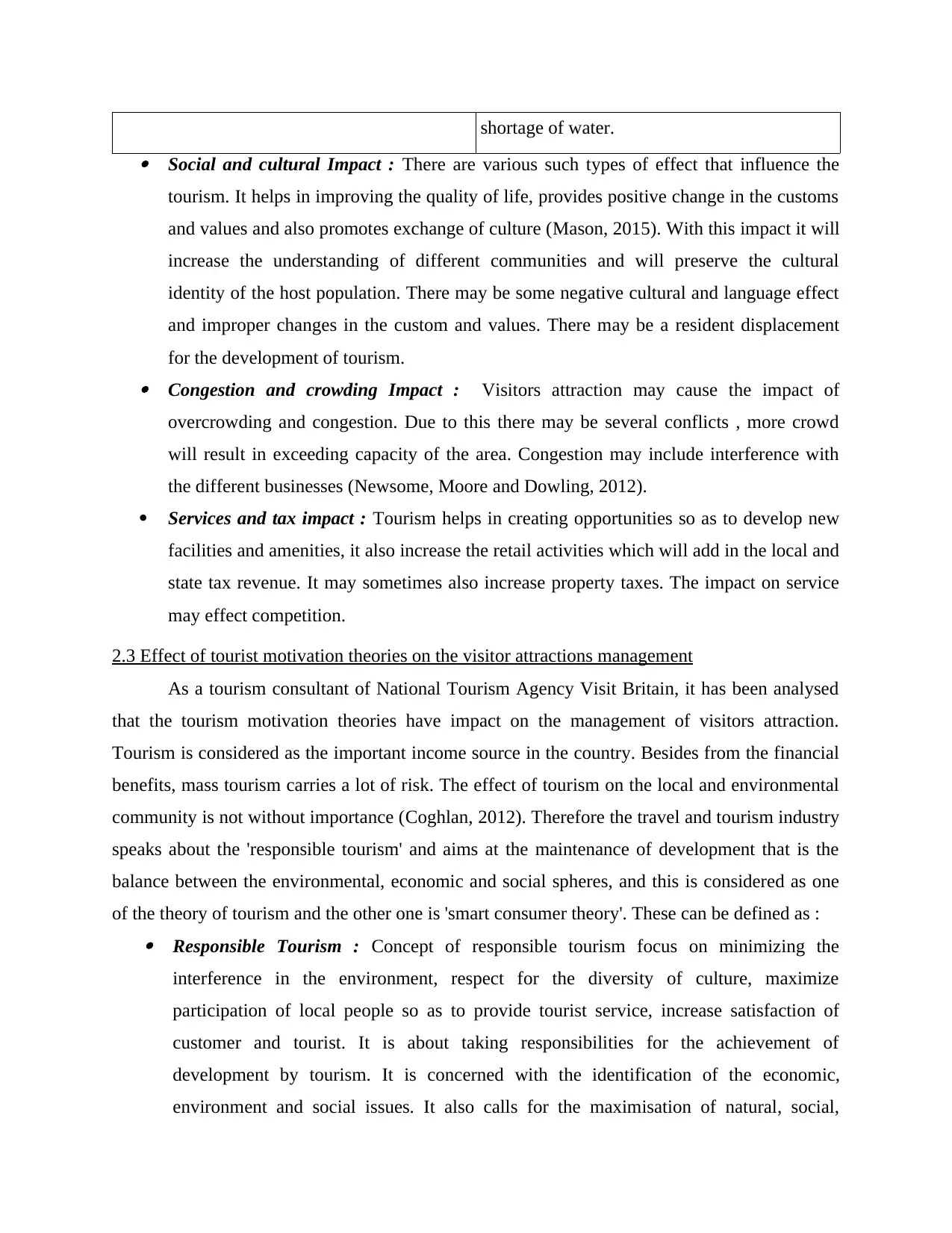
shortage of water. Social and cultural Impact : There are various such types of effect that influence the
tourism. It helps in improving the quality of life, provides positive change in the customs
and values and also promotes exchange of culture (Mason, 2015). With this impact it will
increase the understanding of different communities and will preserve the cultural
identity of the host population. There may be some negative cultural and language effect
and improper changes in the custom and values. There may be a resident displacement
for the development of tourism. Congestion and crowding Impact : Visitors attraction may cause the impact of
overcrowding and congestion. Due to this there may be several conflicts , more crowd
will result in exceeding capacity of the area. Congestion may include interference with
the different businesses (Newsome, Moore and Dowling, 2012).
Services and tax impact : Tourism helps in creating opportunities so as to develop new
facilities and amenities, it also increase the retail activities which will add in the local and
state tax revenue. It may sometimes also increase property taxes. The impact on service
may effect competition.
2.3 Effect of tourist motivation theories on the visitor attractions management
As a tourism consultant of National Tourism Agency Visit Britain, it has been analysed
that the tourism motivation theories have impact on the management of visitors attraction.
Tourism is considered as the important income source in the country. Besides from the financial
benefits, mass tourism carries a lot of risk. The effect of tourism on the local and environmental
community is not without importance (Coghlan, 2012). Therefore the travel and tourism industry
speaks about the 'responsible tourism' and aims at the maintenance of development that is the
balance between the environmental, economic and social spheres, and this is considered as one
of the theory of tourism and the other one is 'smart consumer theory'. These can be defined as : Responsible Tourism : Concept of responsible tourism focus on minimizing the
interference in the environment, respect for the diversity of culture, maximize
participation of local people so as to provide tourist service, increase satisfaction of
customer and tourist. It is about taking responsibilities for the achievement of
development by tourism. It is concerned with the identification of the economic,
environment and social issues. It also calls for the maximisation of natural, social,
tourism. It helps in improving the quality of life, provides positive change in the customs
and values and also promotes exchange of culture (Mason, 2015). With this impact it will
increase the understanding of different communities and will preserve the cultural
identity of the host population. There may be some negative cultural and language effect
and improper changes in the custom and values. There may be a resident displacement
for the development of tourism. Congestion and crowding Impact : Visitors attraction may cause the impact of
overcrowding and congestion. Due to this there may be several conflicts , more crowd
will result in exceeding capacity of the area. Congestion may include interference with
the different businesses (Newsome, Moore and Dowling, 2012).
Services and tax impact : Tourism helps in creating opportunities so as to develop new
facilities and amenities, it also increase the retail activities which will add in the local and
state tax revenue. It may sometimes also increase property taxes. The impact on service
may effect competition.
2.3 Effect of tourist motivation theories on the visitor attractions management
As a tourism consultant of National Tourism Agency Visit Britain, it has been analysed
that the tourism motivation theories have impact on the management of visitors attraction.
Tourism is considered as the important income source in the country. Besides from the financial
benefits, mass tourism carries a lot of risk. The effect of tourism on the local and environmental
community is not without importance (Coghlan, 2012). Therefore the travel and tourism industry
speaks about the 'responsible tourism' and aims at the maintenance of development that is the
balance between the environmental, economic and social spheres, and this is considered as one
of the theory of tourism and the other one is 'smart consumer theory'. These can be defined as : Responsible Tourism : Concept of responsible tourism focus on minimizing the
interference in the environment, respect for the diversity of culture, maximize
participation of local people so as to provide tourist service, increase satisfaction of
customer and tourist. It is about taking responsibilities for the achievement of
development by tourism. It is concerned with the identification of the economic,
environment and social issues. It also calls for the maximisation of natural, social,
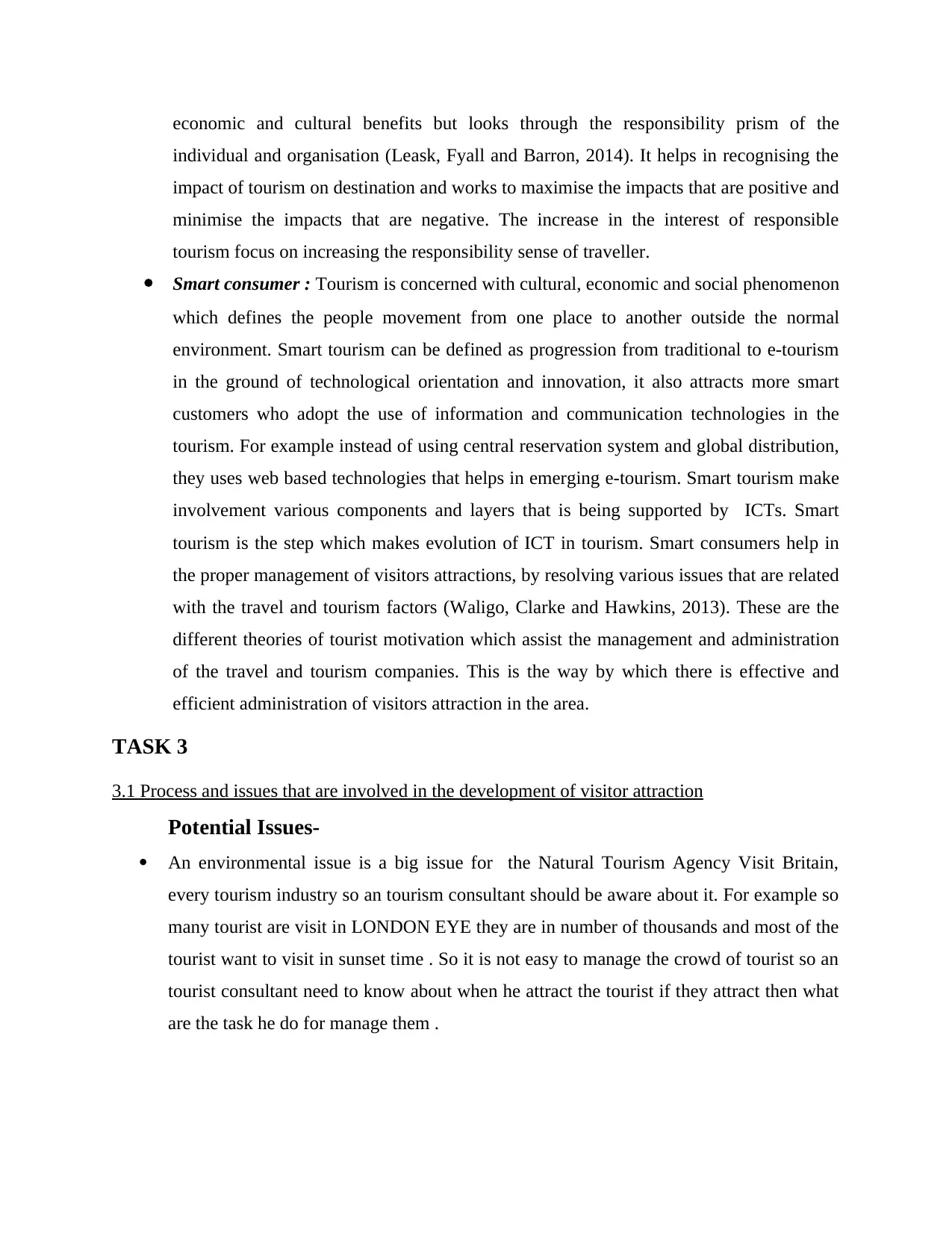
economic and cultural benefits but looks through the responsibility prism of the
individual and organisation (Leask, Fyall and Barron, 2014). It helps in recognising the
impact of tourism on destination and works to maximise the impacts that are positive and
minimise the impacts that are negative. The increase in the interest of responsible
tourism focus on increasing the responsibility sense of traveller.
Smart consumer : Tourism is concerned with cultural, economic and social phenomenon
which defines the people movement from one place to another outside the normal
environment. Smart tourism can be defined as progression from traditional to e-tourism
in the ground of technological orientation and innovation, it also attracts more smart
customers who adopt the use of information and communication technologies in the
tourism. For example instead of using central reservation system and global distribution,
they uses web based technologies that helps in emerging e-tourism. Smart tourism make
involvement various components and layers that is being supported by ICTs. Smart
tourism is the step which makes evolution of ICT in tourism. Smart consumers help in
the proper management of visitors attractions, by resolving various issues that are related
with the travel and tourism factors (Waligo, Clarke and Hawkins, 2013). These are the
different theories of tourist motivation which assist the management and administration
of the travel and tourism companies. This is the way by which there is effective and
efficient administration of visitors attraction in the area.
TASK 3
3.1 Process and issues that are involved in the development of visitor attraction
Potential Issues-
An environmental issue is a big issue for the Natural Tourism Agency Visit Britain,
every tourism industry so an tourism consultant should be aware about it. For example so
many tourist are visit in LONDON EYE they are in number of thousands and most of the
tourist want to visit in sunset time . So it is not easy to manage the crowd of tourist so an
tourist consultant need to know about when he attract the tourist if they attract then what
are the task he do for manage them .
individual and organisation (Leask, Fyall and Barron, 2014). It helps in recognising the
impact of tourism on destination and works to maximise the impacts that are positive and
minimise the impacts that are negative. The increase in the interest of responsible
tourism focus on increasing the responsibility sense of traveller.
Smart consumer : Tourism is concerned with cultural, economic and social phenomenon
which defines the people movement from one place to another outside the normal
environment. Smart tourism can be defined as progression from traditional to e-tourism
in the ground of technological orientation and innovation, it also attracts more smart
customers who adopt the use of information and communication technologies in the
tourism. For example instead of using central reservation system and global distribution,
they uses web based technologies that helps in emerging e-tourism. Smart tourism make
involvement various components and layers that is being supported by ICTs. Smart
tourism is the step which makes evolution of ICT in tourism. Smart consumers help in
the proper management of visitors attractions, by resolving various issues that are related
with the travel and tourism factors (Waligo, Clarke and Hawkins, 2013). These are the
different theories of tourist motivation which assist the management and administration
of the travel and tourism companies. This is the way by which there is effective and
efficient administration of visitors attraction in the area.
TASK 3
3.1 Process and issues that are involved in the development of visitor attraction
Potential Issues-
An environmental issue is a big issue for the Natural Tourism Agency Visit Britain,
every tourism industry so an tourism consultant should be aware about it. For example so
many tourist are visit in LONDON EYE they are in number of thousands and most of the
tourist want to visit in sunset time . So it is not easy to manage the crowd of tourist so an
tourist consultant need to know about when he attract the tourist if they attract then what
are the task he do for manage them .
⊘ This is a preview!⊘
Do you want full access?
Subscribe today to unlock all pages.

Trusted by 1+ million students worldwide
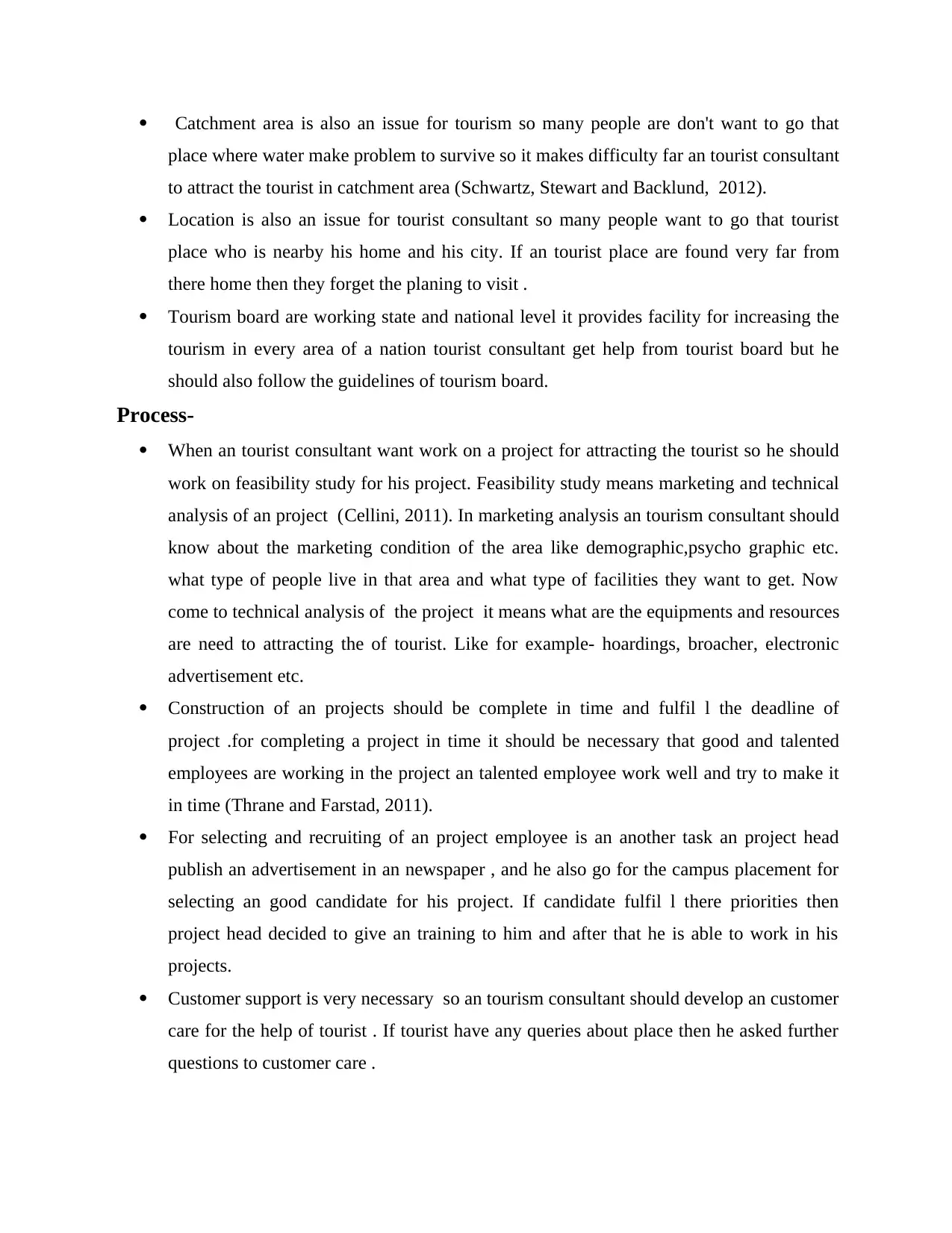
Catchment area is also an issue for tourism so many people are don't want to go that
place where water make problem to survive so it makes difficulty far an tourist consultant
to attract the tourist in catchment area (Schwartz, Stewart and Backlund, 2012).
Location is also an issue for tourist consultant so many people want to go that tourist
place who is nearby his home and his city. If an tourist place are found very far from
there home then they forget the planing to visit .
Tourism board are working state and national level it provides facility for increasing the
tourism in every area of a nation tourist consultant get help from tourist board but he
should also follow the guidelines of tourism board.
Process-
When an tourist consultant want work on a project for attracting the tourist so he should
work on feasibility study for his project. Feasibility study means marketing and technical
analysis of an project (Cellini, 2011). In marketing analysis an tourism consultant should
know about the marketing condition of the area like demographic,psycho graphic etc.
what type of people live in that area and what type of facilities they want to get. Now
come to technical analysis of the project it means what are the equipments and resources
are need to attracting the of tourist. Like for example- hoardings, broacher, electronic
advertisement etc.
Construction of an projects should be complete in time and fulfil l the deadline of
project .for completing a project in time it should be necessary that good and talented
employees are working in the project an talented employee work well and try to make it
in time (Thrane and Farstad, 2011).
For selecting and recruiting of an project employee is an another task an project head
publish an advertisement in an newspaper , and he also go for the campus placement for
selecting an good candidate for his project. If candidate fulfil l there priorities then
project head decided to give an training to him and after that he is able to work in his
projects.
Customer support is very necessary so an tourism consultant should develop an customer
care for the help of tourist . If tourist have any queries about place then he asked further
questions to customer care .
place where water make problem to survive so it makes difficulty far an tourist consultant
to attract the tourist in catchment area (Schwartz, Stewart and Backlund, 2012).
Location is also an issue for tourist consultant so many people want to go that tourist
place who is nearby his home and his city. If an tourist place are found very far from
there home then they forget the planing to visit .
Tourism board are working state and national level it provides facility for increasing the
tourism in every area of a nation tourist consultant get help from tourist board but he
should also follow the guidelines of tourism board.
Process-
When an tourist consultant want work on a project for attracting the tourist so he should
work on feasibility study for his project. Feasibility study means marketing and technical
analysis of an project (Cellini, 2011). In marketing analysis an tourism consultant should
know about the marketing condition of the area like demographic,psycho graphic etc.
what type of people live in that area and what type of facilities they want to get. Now
come to technical analysis of the project it means what are the equipments and resources
are need to attracting the of tourist. Like for example- hoardings, broacher, electronic
advertisement etc.
Construction of an projects should be complete in time and fulfil l the deadline of
project .for completing a project in time it should be necessary that good and talented
employees are working in the project an talented employee work well and try to make it
in time (Thrane and Farstad, 2011).
For selecting and recruiting of an project employee is an another task an project head
publish an advertisement in an newspaper , and he also go for the campus placement for
selecting an good candidate for his project. If candidate fulfil l there priorities then
project head decided to give an training to him and after that he is able to work in his
projects.
Customer support is very necessary so an tourism consultant should develop an customer
care for the help of tourist . If tourist have any queries about place then he asked further
questions to customer care .
Paraphrase This Document
Need a fresh take? Get an instant paraphrase of this document with our AI Paraphraser
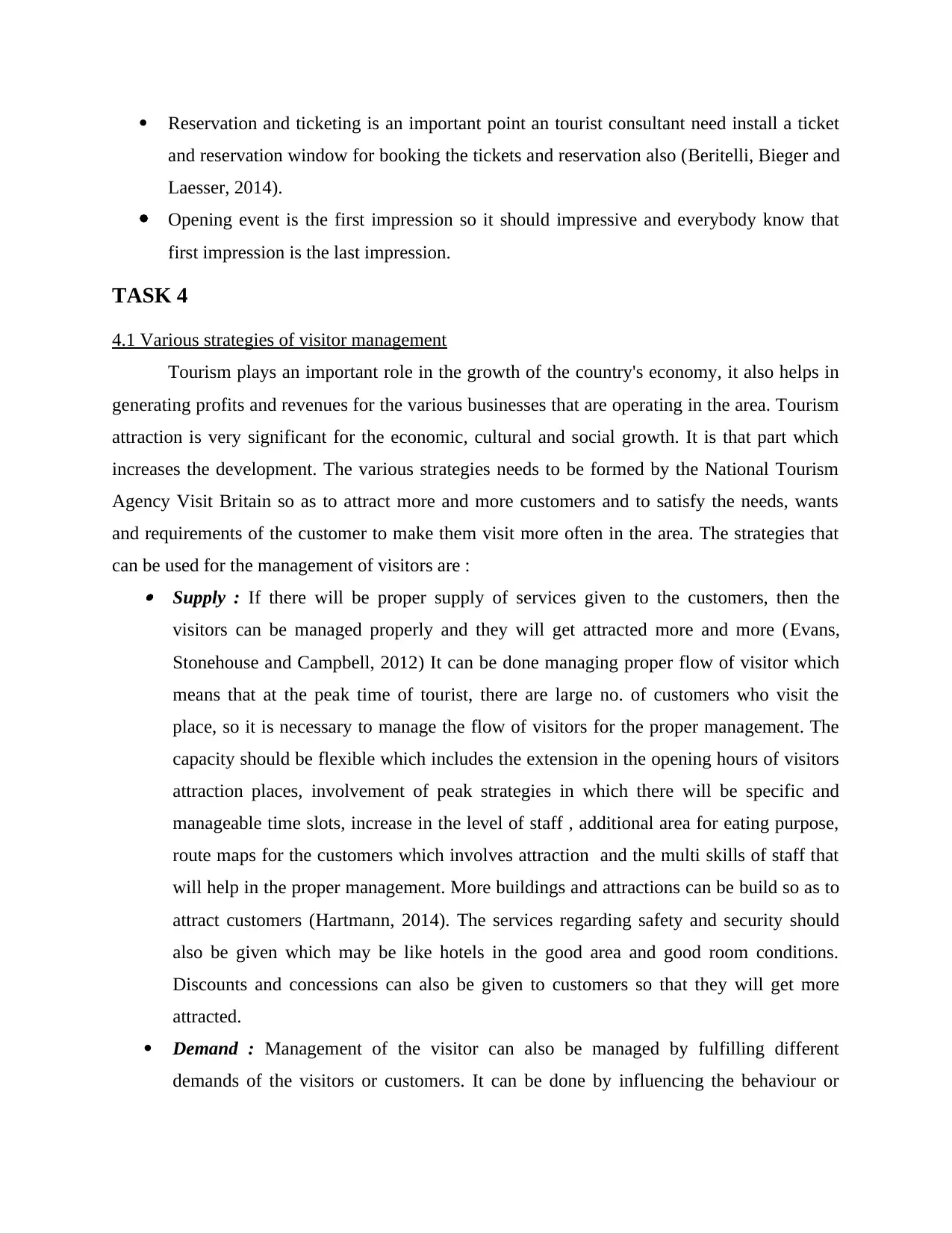
Reservation and ticketing is an important point an tourist consultant need install a ticket
and reservation window for booking the tickets and reservation also (Beritelli, Bieger and
Laesser, 2014).
Opening event is the first impression so it should impressive and everybody know that
first impression is the last impression.
TASK 4
4.1 Various strategies of visitor management
Tourism plays an important role in the growth of the country's economy, it also helps in
generating profits and revenues for the various businesses that are operating in the area. Tourism
attraction is very significant for the economic, cultural and social growth. It is that part which
increases the development. The various strategies needs to be formed by the National Tourism
Agency Visit Britain so as to attract more and more customers and to satisfy the needs, wants
and requirements of the customer to make them visit more often in the area. The strategies that
can be used for the management of visitors are : Supply : If there will be proper supply of services given to the customers, then the
visitors can be managed properly and they will get attracted more and more (Evans,
Stonehouse and Campbell, 2012) It can be done managing proper flow of visitor which
means that at the peak time of tourist, there are large no. of customers who visit the
place, so it is necessary to manage the flow of visitors for the proper management. The
capacity should be flexible which includes the extension in the opening hours of visitors
attraction places, involvement of peak strategies in which there will be specific and
manageable time slots, increase in the level of staff , additional area for eating purpose,
route maps for the customers which involves attraction and the multi skills of staff that
will help in the proper management. More buildings and attractions can be build so as to
attract customers (Hartmann, 2014). The services regarding safety and security should
also be given which may be like hotels in the good area and good room conditions.
Discounts and concessions can also be given to customers so that they will get more
attracted.
Demand : Management of the visitor can also be managed by fulfilling different
demands of the visitors or customers. It can be done by influencing the behaviour or
and reservation window for booking the tickets and reservation also (Beritelli, Bieger and
Laesser, 2014).
Opening event is the first impression so it should impressive and everybody know that
first impression is the last impression.
TASK 4
4.1 Various strategies of visitor management
Tourism plays an important role in the growth of the country's economy, it also helps in
generating profits and revenues for the various businesses that are operating in the area. Tourism
attraction is very significant for the economic, cultural and social growth. It is that part which
increases the development. The various strategies needs to be formed by the National Tourism
Agency Visit Britain so as to attract more and more customers and to satisfy the needs, wants
and requirements of the customer to make them visit more often in the area. The strategies that
can be used for the management of visitors are : Supply : If there will be proper supply of services given to the customers, then the
visitors can be managed properly and they will get attracted more and more (Evans,
Stonehouse and Campbell, 2012) It can be done managing proper flow of visitor which
means that at the peak time of tourist, there are large no. of customers who visit the
place, so it is necessary to manage the flow of visitors for the proper management. The
capacity should be flexible which includes the extension in the opening hours of visitors
attraction places, involvement of peak strategies in which there will be specific and
manageable time slots, increase in the level of staff , additional area for eating purpose,
route maps for the customers which involves attraction and the multi skills of staff that
will help in the proper management. More buildings and attractions can be build so as to
attract customers (Hartmann, 2014). The services regarding safety and security should
also be given which may be like hotels in the good area and good room conditions.
Discounts and concessions can also be given to customers so that they will get more
attracted.
Demand : Management of the visitor can also be managed by fulfilling different
demands of the visitors or customers. It can be done by influencing the behaviour or
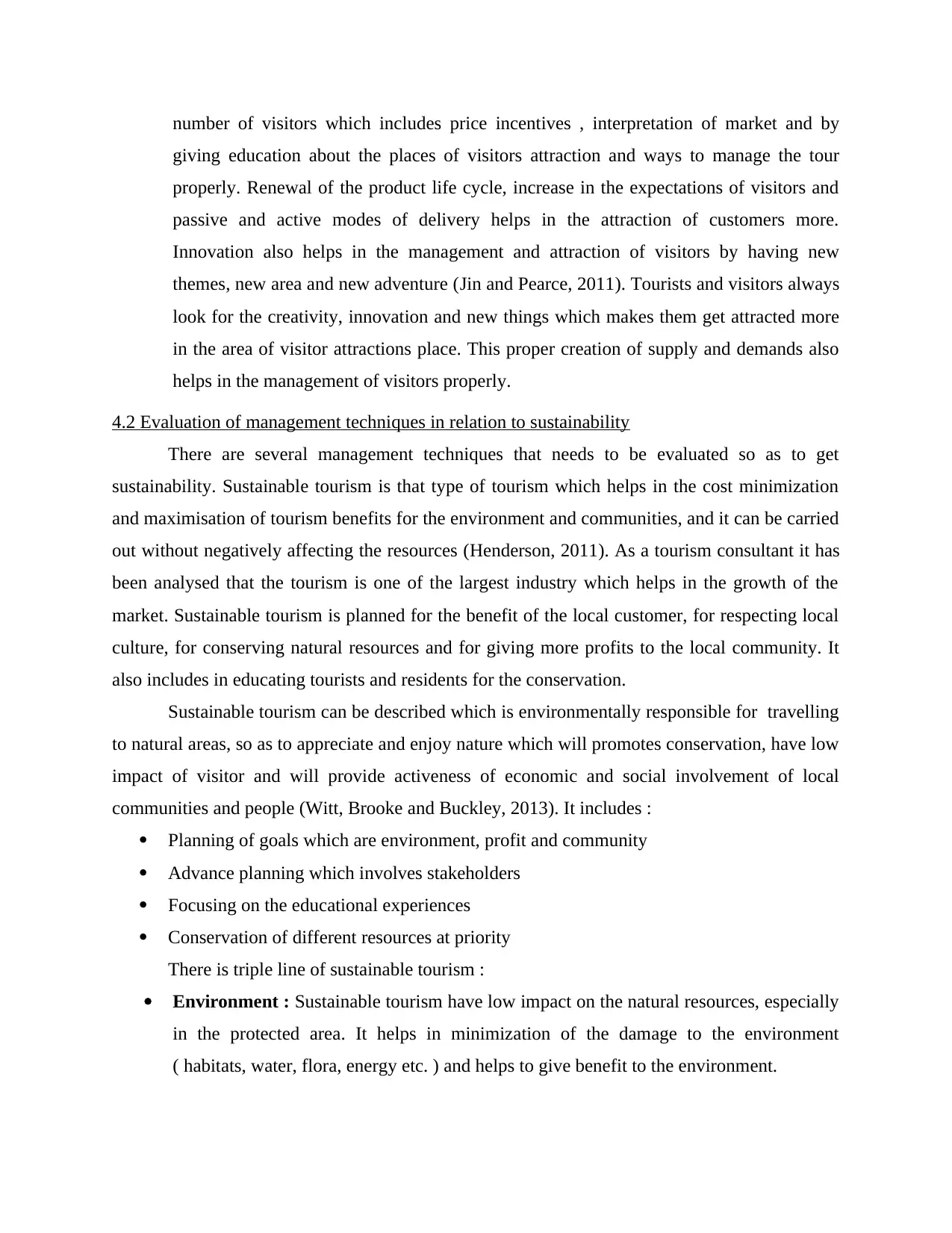
number of visitors which includes price incentives , interpretation of market and by
giving education about the places of visitors attraction and ways to manage the tour
properly. Renewal of the product life cycle, increase in the expectations of visitors and
passive and active modes of delivery helps in the attraction of customers more.
Innovation also helps in the management and attraction of visitors by having new
themes, new area and new adventure (Jin and Pearce, 2011). Tourists and visitors always
look for the creativity, innovation and new things which makes them get attracted more
in the area of visitor attractions place. This proper creation of supply and demands also
helps in the management of visitors properly.
4.2 Evaluation of management techniques in relation to sustainability
There are several management techniques that needs to be evaluated so as to get
sustainability. Sustainable tourism is that type of tourism which helps in the cost minimization
and maximisation of tourism benefits for the environment and communities, and it can be carried
out without negatively affecting the resources (Henderson, 2011). As a tourism consultant it has
been analysed that the tourism is one of the largest industry which helps in the growth of the
market. Sustainable tourism is planned for the benefit of the local customer, for respecting local
culture, for conserving natural resources and for giving more profits to the local community. It
also includes in educating tourists and residents for the conservation.
Sustainable tourism can be described which is environmentally responsible for travelling
to natural areas, so as to appreciate and enjoy nature which will promotes conservation, have low
impact of visitor and will provide activeness of economic and social involvement of local
communities and people (Witt, Brooke and Buckley, 2013). It includes :
Planning of goals which are environment, profit and community
Advance planning which involves stakeholders
Focusing on the educational experiences
Conservation of different resources at priority
There is triple line of sustainable tourism :
Environment : Sustainable tourism have low impact on the natural resources, especially
in the protected area. It helps in minimization of the damage to the environment
( habitats, water, flora, energy etc. ) and helps to give benefit to the environment.
giving education about the places of visitors attraction and ways to manage the tour
properly. Renewal of the product life cycle, increase in the expectations of visitors and
passive and active modes of delivery helps in the attraction of customers more.
Innovation also helps in the management and attraction of visitors by having new
themes, new area and new adventure (Jin and Pearce, 2011). Tourists and visitors always
look for the creativity, innovation and new things which makes them get attracted more
in the area of visitor attractions place. This proper creation of supply and demands also
helps in the management of visitors properly.
4.2 Evaluation of management techniques in relation to sustainability
There are several management techniques that needs to be evaluated so as to get
sustainability. Sustainable tourism is that type of tourism which helps in the cost minimization
and maximisation of tourism benefits for the environment and communities, and it can be carried
out without negatively affecting the resources (Henderson, 2011). As a tourism consultant it has
been analysed that the tourism is one of the largest industry which helps in the growth of the
market. Sustainable tourism is planned for the benefit of the local customer, for respecting local
culture, for conserving natural resources and for giving more profits to the local community. It
also includes in educating tourists and residents for the conservation.
Sustainable tourism can be described which is environmentally responsible for travelling
to natural areas, so as to appreciate and enjoy nature which will promotes conservation, have low
impact of visitor and will provide activeness of economic and social involvement of local
communities and people (Witt, Brooke and Buckley, 2013). It includes :
Planning of goals which are environment, profit and community
Advance planning which involves stakeholders
Focusing on the educational experiences
Conservation of different resources at priority
There is triple line of sustainable tourism :
Environment : Sustainable tourism have low impact on the natural resources, especially
in the protected area. It helps in minimization of the damage to the environment
( habitats, water, flora, energy etc. ) and helps to give benefit to the environment.
⊘ This is a preview!⊘
Do you want full access?
Subscribe today to unlock all pages.

Trusted by 1+ million students worldwide
1 out of 15
Related Documents
Your All-in-One AI-Powered Toolkit for Academic Success.
+13062052269
info@desklib.com
Available 24*7 on WhatsApp / Email
![[object Object]](/_next/static/media/star-bottom.7253800d.svg)
Unlock your academic potential
Copyright © 2020–2025 A2Z Services. All Rights Reserved. Developed and managed by ZUCOL.





